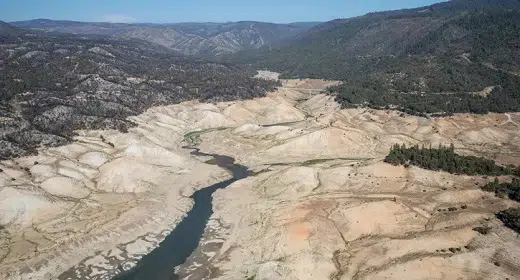by Ryan Slattery: Alarming low water levels are closing power plants and reducing production at others…
What’s happening with water issues in the U.S. West is more than just concerning. With wildfires raging and water sparse, it’s been a rough summer and unfortunately, forecasts for this fall and winter aren’t too promising. The National Oceanic and Atmospheric Administration (NOAA) is predicting warm and dry conditions to continue through November and beyond.1
The visible signs of America’s lingering drought are obvious at reservoirs across the American West. Drive from Las Vegas and step out of your car at Hoover Dam and Lake Mead in Nevada or peek out at Lake Powell on the Arizona-Utah border, and you’ll see the stone-stained “bathtub rings” indicating the high-water marks of better times.
Now, it’s just an ugly reminder of how bad things have gotten. The lack of rain and snowfall in recent years has left the western U.S. so deep in drought that it not only caused a water and energy crisis the country may find difficult to dig its way out of but has also dried out forests that have been ravaged by wildfires.
It’s a dramatic situation and a reality that water and power production managers wake up to or lose sleep over daily.
Because as water levels drop, the unseen effect of these drastic reservoir declines is that hydroelectric power is decreasing. These dams and reservoirs are being pushed into an entirely new realm as the production of must-needed cleaner electricity lessens with each passing day. And August was a bad month.
On August 5, the first causality was witnessed as California water managers shut down hydropower generation at Lake Oroville when, for the first time since opening in 1967, falling lake levels made it impossible for the plant to produce power. Then, on August 16, federal officials announced the first-ever Tier 1 water shortage at Lake Mead, the nation’s largest reservior, prompting new water restrictions and limiting allocations to certain states and segments of the population including central Arizona farmers who will see less water for irrigating crops.
September is off to an equally bleak start, as Lake Oroville’s water level is reportedly at its lowest level recorded since September 1977.
A U.S. Bureau of Reclamation (USBR) report shows several of its 44 major reservoirs including Hoover Dam at Lake Mead and Glen Canyon Dam at Lake Powell have now fallen to their lowest storage levels in 30 years. As a result, Hoover Dam is producing 25% less electricity.
“Like much of the West, and across our connected basins, the Colorado River is facing unprecedented and accelerating challenges,” said Tanya Trujillo, assistant secretary for Water and Science. “The only way to address these challenges and climate change is to utilize the best available science and to work cooperatively across the landscapes and communities that rely on the Colorado River.”
When the Edward Hyatt Powerplant at Lake Oroville went offline, California’s second-largest reservoir was also at a record low. It now sits at 23% capacity at an elevation level of 631 feet. The plant has the ability to produce 750 megawatts of energy but typically supplies between 100-400 megawatts depending on lake levels.2
The shutdown was not a surprise to officials at California’s Department of Water Resources as director Karla Nemeth pointed out in a news release. “DWR anticipated this moment, and the state has planned for its loss in both water and grid management,” Nemeth said. “This is just one of many unprecedented impacts we are experiencing in California as a result of our climate-induced drought. California and much of the western part of the United States are experiencing the impacts of accelerated climate change including record-low reservoir levels due to dramatically reduced runoff this spring.”
While the Hyatt Powerplant closure is historic in its own right, it could slowly become the new normal. Hydropower plants across the nation have been producing less energy for years and as the climate crisis continues it only worsens.
Two of California’s other major reservoirs are dropping as well, which of course, means less power production. Shasta Lake, California’s largest reservoir is at 29% capacity, while Trinty Lake is at 38% capacity. Both are generating 30% less power than a typical summer.
But the problem is far worse statewide. According to the U.S. Energy Information Administration, California’s hydroelectric generation in the first four months of 2021 was 37% less than in the same period a year ago and 71% less than during those months in 2019.3
And while California hydropower only accounts for roughly 10% of the state’s entire power generation, the loss is felt and must be replaced with other sources putting an additional strain on the power grid and making for a higher reliance on fossil fuels, which in turn emit gases that are directly linked to accelerating climate change.3 According to the California Energy Commission, the state relies on natural gas for about 47% of its energy needs, while renewable sources such as solar, wind, biomass, and geothermal account for nearly one-third of the state’s remaining energy production.





















































